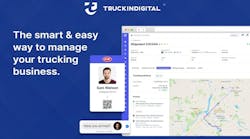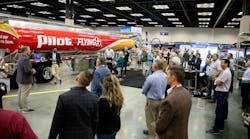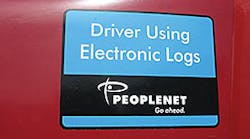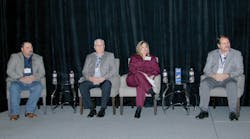REGULATED electronic driver logs (ELDs) are coming. But don’t wait until the regulations are fully implemented in 2017. Get busy right now.
That’s the advice of Thomas Bray, senior editor of transportation management for JJ Keller & Associates Inc, and the members of the panel he moderated, “Hours of Service, Successful Implementation of Electronic Logging Systems & Best Practices Used by Fleets.” The panel consisted of: Becky Perlaky, executive vice-president of Kenan Advantage Group; Griff Odgers, vice-president of safety and risk management at Andrews Logistics; and Randy Vaughn, vice-president of administration and risk management at Superior Bulk Logistics.
The ELD proposal was released last March and stated that drivers who complete mandatory hours-of-service logbooks would be required to switch over to ELDs. It provided a two-year implementation period in which the final rule could be released in early to mid-2015, with full implementation in 2017.
“Two years sounds like a lot of time,” Bray said. “It does until you start messing with something like hours of service and changing entire fleets’ culture. Two years is a short time frame to get an entire fleet from paper logs all the way through the tunnel using electronic logging devices.”
Bray encouraged companies to celebrate successes to reinforce the change.
“This is a huge change for a company,” he said. “Everybody has to be on board and moving in the same direction. You can’t take the typical approach we sometimes take in safety: ‘You’re going to do it my way because I said.’ You have to work forward with this process a little differently.
“If you have a senior driver who was dead set against it and suddenly he’s the biggest proponent, get him out in front of people and talking about it. If you see a big drop in violations, get that out to the drivers and management and let them know, ‘Hey this is working. We’re seeing good results. This is getting you off the roadside inspection list so they’re not bothering you.’ ”
How do you get there?
He said transitioning from paper to electronic takes time and effort and requires a disciplined “change management approach”.
“If you look at it like, ‘We’re going to plug in the devices and let data flow, it’s not going to work,” he said. “You have to have a disciplined approach.”
Here’s how the three panelists approached it:
Perlaky: “We did trial and error in 2006. We found that it took more resources than we truly felt were necessary, so when we actually decided to jump in with both feet, we put together a team responsible for everything from installation to going out on routes to different areas and trained the terminal, personnel, and drivers. We’d leave educational materials behind and move on to another location. We found that questions are going to come up after individuals leave the facility. It’s a lot of information for them, so we set up a 24-hour help desk drivers can call, and individuals at the help desk walk the driver through what needs to happen in terms of problems with logging in and off, and how to confirm logs.”
Vaughn: “We had some teams go out and we found out who our champions were at each terminal location, then we did extensive training and rolled out ELDs one terminal at a time. We’re now 100% electronic logs through all divisions. When we started the process, we thought, ‘We‘re going to lose drivers.’ That was the mindset. We were very cautious of that, so we started looking at the key drivers. We picked two or three owner-operators who would be, ‘No way I want this in the truck.’ I knew once they got it into the truck, they would be my champions. They talked within their group. Overall, it’s been a real positive in our corporation.”
Odgers: “We’re brand new to implementing electronic logs at Andrews. We were very worried about driver retention. We started a year in advance, trying to lay the foundation that electronic logs were coming. Around March (2014), we started bringing electronic logs on board. We wanted to be very methodical, so we started with one terminal at a time. They did like it and became a big advocate for it. Drivers, from my side of the desk, have been more receptive. A few were pushing back, but more were happy. Since March (2014), when we put them onboard, there were a few locations where we sent portable units home with terminal managers before we ever put them in the trucks , and we made them learn because those were going to be the guys the drivers would be coming to see. They got really familiar with it. So far, I’ve found some of the terminal managers and dispatch crew are a little slower in being able to help the drivers function. I wish we had sent portable units home with every single terminal manager.”
Bray said there are serious consequences if not done well, and a “fast and messy” approach leads to problems.
To prepare for the change:
• Secure sign-off from all of senior management, not just some. “We did not have any issues at all,” Perlaky said. “Senior management strongly encouraged it. We had one facility that I can think of where we lost six drivers as soon as we said we were putting in electronic logs. I can honestly tell you that four months later, those drivers came back to us. They committed to the system and are still with us today. Communication is very important. It has to come from senior management. It truly has to be supported at every level at the local level with the terminal manager and senior management. We had each of our managers sign off on correspondence.”
Bray suggested assigning a project sponsor who must be a member of senior management. That will keep the project going forward when resistance is met.
• Form a project team. “Assign a project leader to oversee the day-to-day activities and liaison with the vendors,” Bray said. “Include all of the managers in affected areas, which means all areas of the company. Include driver representation. Driver participation and input will be critical.”
• Define the project. “Where are you? Where are you going? What do you need the device and system to do? How ‘driver-friendly’? How ‘staff-friendly’? Do you want more than simply recording HOS information? Will this create a drop in revenue? If so, why?”
• System selection criteria. “What return on investment? Remember to not ‘overbuy’ in terms of your needs versus wants. The cost of the system can be offset by several factors: productivity gains; increased awareness of fleet availability; compliance gains; reduction of risk; and reduction in fines paid.”
• Compare the various vendors’ systems to your “desired future state.” “Verify each vendor’s experience and qualifications. Verify implementation and ongoing support mechanisms. Mixed fleets may need to consider a combination of vendors.”
• Tighten up HOS compliance efforts. “Concentrate on the accuracy of logs and the adherence to limits. Remember to retrain supervisors on HOS rules and limits. Drivers and supervisors will need to adjust to the accuracy and speed of the electronic logging system.”
• Plan device installation. “That involves in-house versus outsourced, training of technicians, physical mechanics of installation, time to install, device ‘setup’ time and process device testing, and method/process for requesting install.”
To manage the change:
• Develop the day-to-day policies and procedures. “Who will have authority to do what within the system? How are repair and replacement issues going to be handled? Who will make corrections for the drivers? What types of situations will lead to immediate discipline and what will the discipline be?”
• Training drivers. “How to use the electronic logs during normal operation, request a correction, and use the electronic logs during a roadside inspection. Do not underestimate the amount of training and coaching the drivers will need.”
• Training supervisors. “Specifics of HOS compliance as they relate to the electronic logging system being implemented, how and when to make corrections, how to locate a driver’s available hours in the system.”
• Timing of the training. “Who will be trained and when, based on your timeline. You may want to start by only training the drivers and supervisors that are being switched initially and waiting on training the others.”
• Summary of the actual “rollout.”
Step 1: Pilot group/Beta test. “Roll out the use of the ELDs in phases using a control group. Include your ‘best drivers.’ Review your processes related to sorting and using data. Review the effectiveness of your training programs.”
Step 2: Expand the implementation. “Bring in ‘good’ drivers and supervisors, and drivers that will appreciate the devices. Continue to work with the drivers that are only in marginal compliance with the HOS rules before placing them onto an ELD.”
Step 3: Expand implementation to all drivers and supervisors. “It may be the most difficult group: ‘holdout’ drivers and supervisors with a recent history of HOS compliance problems.”
To reinforce the change:
• Monitor and track the processes and results. “That includes the system itself, the reports the system is generating, error rates, violation rate, and calls for assistance/technical support.”
• Conduct follow-up training with employees who are showing problems with the system or with compliance. “Be prepared to manage resistance. Monitor for possible saboteurs. Watch out and be prepared for ‘cheaters.’ Methods drivers and supervisors may use to cheat: sharing logins; drivers/supervisors using ‘ghost driver’ accounts to hide miles/hours; not logging in or logging out while working/driving; unauthorized edits; system tampering; logging off duty for everything.” ♦
2014 Tank Truck Week coverage on Telematics for the trucking industry
Find the NTTC Tank Truck Week archive with articles from 2014 to present









![On hand to discuss pending federal regulations on electronic driver logs during a 2014 Tank Truck Week panel were [from left] Griff Odgers, Andrews Logistics Inc; Randy Vaughn, Superior Bulk Logistics; and Becky Perlaky, Kenan Advantage Group. Panel moderator was Thomas Bray, JJ Keller & Associates Inc. On hand to discuss pending federal regulations on electronic driver logs during a 2014 Tank Truck Week panel were [from left] Griff Odgers, Andrews Logistics Inc; Randy Vaughn, Superior Bulk Logistics; and Becky Perlaky, Kenan Advantage Group. Panel moderator was Thomas Bray, JJ Keller & Associates Inc.](https://img.bulktransporter.com/files/base/ebm/bulktransporter/image/2019/04/bulktransporter_885_ttw_electronic_logs_panel.png?auto=format,compress&fit=crop&q=45&h=139&height=139&w=250&width=250)

